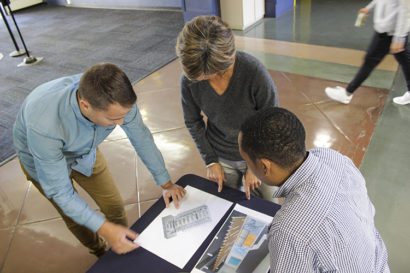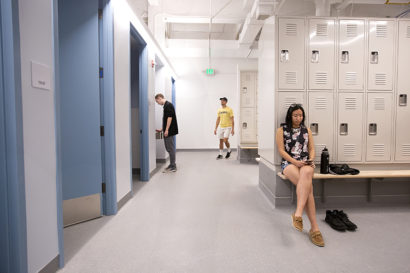A first in California: Berkeley opens large-scale universal locker room
More privacy is offered to students who are transgender, non-binary or have disabilities
September 25, 2018
Like many transgender students at UC Berkeley, Juniperangelica Cordova would get anxious each time she considered a workout at the campus gym.
“I wondered, ‘Am I going to use the locker room? Take a shower?’” says the ethnic studies major. “I like to work out, but I’d often avoid the locker room and go home with dirty clothes, or not go to the gym at all.”
While Cordova says Berkeley has become “a safer place for trans people to voice our needs and concerns,” she adds that students can’t fully participate in college life if there are places where they fear stares and harassment.
[image360 image_id=”70071″ caption=”Get a 360-degree look at the universal locker room. (UC Berkeley photo by Stephen McNally)”]
The opening tomorrow (Sept. 26) of a 4,500-square-foot universal locker room at the campus’s Recreational Sports Facility (RSF) — it’s believed to be the first large-scale collegiate universal locker room in California and one of just a few in the nation — will help change that experience. Any students or other RSF members needing more privacy, including those who are transgender, non-binary or have disabilities or body image struggles, will find a welcoming facility next door to the men’s and women’s locker rooms.

The RSF’s new $2.7 million universal locker room opens Wednesday, Sept. 26. Students voted to pay for it themselves over the course of 30 years. (UC Berkeley photo by Brittany Hosea-Small)
The $2.7 million locker room has its own entrance, 400 lockers, 16 individual changing rooms, seven private showers, five private toilets and four shared sinks. It also leads to Spieker Pool, which, in the past, some students avoided, since it was only accessible through the existing locker rooms.
“Our belief is that this will be a very popular place,” says Brigitte Lossing, Berkeley Rec Sports interim associate director, of the new locker room. “We’d heard from some students who were uncomfortable, we knew there were more, and we spoke with colleagues who work with those populations. We’re here to serve everyone; we’re always thinking of ways to remove barriers to fitness and wellness.”
For students with disabilities, access also is a “huge issue, and space for them isn’t always taken into account,” says Martha Velasquez, associate director of the campus’s Disabled Students’ Program. “Now, those who might have automatically assumed they couldn’t use the RSF locker room will feel welcome.”
A student-funded project
Remarkably, the new space is being paid for entirely by students. In a 2015 Wellness Referendum, the student body voted to impose an annual fee of $146 upon themselves — the fee contains a built-in escalator tied to inflation and is currently $160 — for 30 years. Those fees go into a Wellness Fund that, according to the fund’s website, is for “new, innovative mind-body services” that “address the concerning rise of mental health complications on campus and provide new support for minority student groups.”

From left, William Morrow, former ASUC president; RSF Interim Associate Director Brigitte Lossing and Trineice Durst, former RSF associate director, look at renderings of the new facility. (UC Berkeley photo by Jeremy Snowden)
So far, the fund has provided for initiatives that include counseling services for historically under-resourced student communities, medical care for student survivors of sexual violence and a pilot program for emergency housing.
For many years, Rec Sports staff and student leaders were aware of students who felt the gym wasn’t a service for them. Small accommodations, such as a few shower curtains for privacy, were made at the RSF, but funds were lacking for what then was called a “gender inclusive” locker room.
Project team
Contractor: James R. Griffin, Inc.
Architect: ELS Architecture and Urban Design
Project management: UC Berkeley Capital Projects
On-site construction coordinator: Chris Lochtefeld, James R. Griffin, Inc.
Then, during the 2014-15 school year, a group of student leaders — concerned about growing student enrollment and the inability of health and wellness services to keep pace — designed the referendum. It passed overwhelmingly, and one of the first requests to the resulting Wellness Fund was from Rec Sports, for a study to explore the size and scope of a third locker room for under-served populations.
Funding was approved, and in 2016, William Morrow, then-president of the Associated Students of the University of California (ASUC) and Trineice Durst, then-Rec Sports associate director, led the creation of a proposal for the project — financially self-sustaining and free of the need for state or campus dollars — and submitted it to the Wellness Fee Advisory Committee and campus administrators.

Morrow (left), Durst and Lossing each played a major role in making the new universal locker room a reality. (UC Berkeley photo by Jeremy Snowden)
“As we started describing the type of design for the locker room, it became clear there were others who would benefit,” including students, staff and faculty with disabilities, says Billy Curtis, director of Berkeley’s Gender Equity Resource Center. A consultant for the project, he suggested the new facility be called a “universal” locker room.
“’Universal’ is the term today,” Curtis explains. “It says everyone.”
The committee passed the proposal in fall 2016, and in June 2017, the campus’s chief financial officer provided an interest-free loan to Rec Sports to fund the project; the loan will be repaid over 15 years through students’ Wellness Fees.
Student Yongqi Gan, committee chair, says the locker room initiative “was a matter of equity and access.” It also was the most costly proposal the committee has funded and included an important benefit for all three RSF locker rooms — ADA standards of accessibility.
An intentional step forward
Ben Perez remembers being a new student at Berkeley in 2007 and how it felt to suddenly be faced with sharing a residence hall bathroom and showers with 25 other students. After a spinal cord injury at age 16, he has used wheelchairs, including a special one for bathing.
Every and any moment in which the university identifies and proactively moves an access barrier to make spaces more inclusive is a big moment. Every time we do so without a mandate, but with intention, is an especially important moment, because it sets a tone.
– Ben Perez, manager of Campus Access Services
“My disability life had been a private thing,” says Perez. “My parents were involved, my two closest friends and my caretakers. I cannot tell you how mortified I was. I didn’t want to look disabled at that time. I would have valued a little bit of space to learn how to be comfortable with myself.”

Ben Perez, manager of Campus Access Services, checks out the new universal locker room. (UC Berkeley photo by Brittany Hosea-Small)
Today, as manager of Berkeley’s Campus Access Services, Perez is the point person for advice on making programs, services and activities either accessible or more so for those on campus with disabilities. While he says Berkeley “has more work to do,” he adds that it continues its “long history of building accessible spaces, and of students coming to occupy them.” For example, the campus for several years has been installing gender-inclusive restrooms, many of them ADA-accessible, in dozens of buildings.
Perez says the RSF, like its satellite fitness center at Memorial Stadium, is “the most accessible gym I can imagine. We might not have every piece of equipment for everyone’s disability needs, but it’s a facility that checks a lot of boxes, a lot of those needs are met. And with the new locker room, our students will take advantage of it.”

The new locker room has 400 lockers, 16 individual changing rooms, seven private showers and five private toilets. (UC Berkeley photo by Brittany Hosea-Small)
The new RSF facility also has a private room with an adult changing table that exceeds ADA requirements, says Lossing, and high-quality, slip-resistant flooring that, like the locker room’s paint and other materials, is free of toxic chemicals that can create fumes.
Among those who may value the universal locker room are individuals who are “on the spectrum, have PTSD, or other psychological disabilities. Some may have a sensory disability and need a more private space to change,” says Velasquez, adding that some 2,500 students are registered with the Disabled Students’ Program.
“For people with anxiety,” adds Perez, “changing into gym clothes is a huge source of discomfort; some people don’t go to the gym because they don’t want to be seen getting ready. Our social fabric contains a really specific and narrow vision of what someone who goes to a gym should look like.”
[image360 image_id=”70072″ caption=”A 360-degree look at a shower for people with disabilities (UC Berkeley photo by Stephen McNally)”]
Cordova, a former ASUC senator who is working on a transgender student wellness initiative as an intern with the campus’s Multicultural Community Center, says the physical privacy of the new locker room will take worry out of her fitness routine.
But more than that, she explains, the space is “a step forward for the campus and the atmosphere for trans students; the powerful part of this is the intentionality behind it.”
At its foundation, says Stephen E. Sutton, vice chancellor for the Division of Students Affairs, “are Berkeley’s values of diversity, equity, inclusion and social justice.”
“Every and any moment in which the university identifies and proactively moves an access barrier to make spaces more inclusive is a big moment,” adds Perez. “Every time we do so without a mandate, but with intention, is an especially important moment, because it sets a tone.”
More information about the universal locker room can be found here.